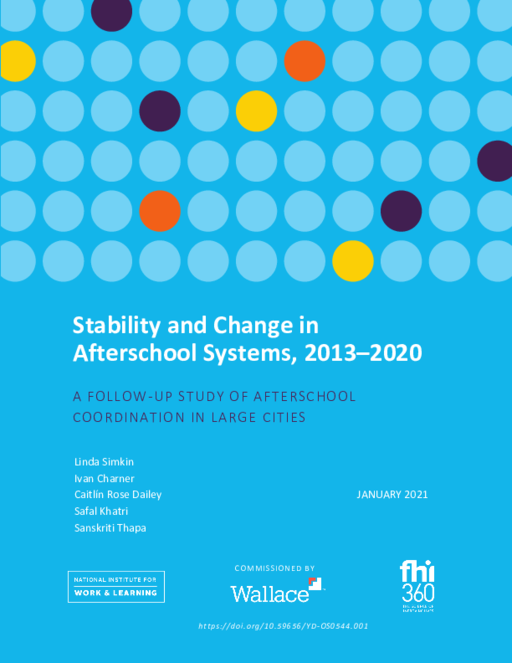Breadcrumb
- Wallace
- Reports
- Stability And Change In Aftersch...
Stability and Change in Afterschool Systems, 2013-2020
A Follow-Up Study of Afterschool Coordination in Large Cities

- Author(s)
- Linda Simkin, Ivan Charner, Caitlin Rose Dailey, and Safal Khatri
- Publisher(s)
- National Institute for Work and Learning
Summary
How we did this
FHI 360 researchers drew on 75 of the 77 cities they had examined in 2013 to conduct a 2020 follow-up study, which was carried out entirely by survey. In 2020, the researchers identified knowledgeable contacts in 67 of the communities. Screening questions then determined which respondents took the survey, which consisted of both fixed-response and open-ended questions. Survey responses were entered into the study’s SurveyMonkey database and analyzed.
Because data collection ended immediately before the COVID-19 pandemic radically changed the afterschool landscape, findings reflect a time before schools and afterschool programs closed or were reconfigured.
Nevertheless, the findings in this report provide insights into factors that affect coordination.
Children need places to feel safe, achieve academically, and grow socially and emotionally. Citywide systems that coordinate the work of afterschool programming help ensure that high-quality out-of-school-time (OST) programs reach children who need them most.
In 2012, The Wallace Foundation commissioned an exploratory study to determine how many U.S. cities with populations of more than 100,000 people had, or were building, elements of citywide OST systems. Of 100 randomly selected large U.S. cities, researchers found that 77 coordinated some elements of afterschool programming.
This 2020 follow-up study assesses whether and how the 77 cities sustained or expanded their OST coordination over time. It also identifies the conditions that contributed to growth and sustainability.
From 2013 to 2020
Altogether, three-fourths of the original 77 cities coordinating OST in 2013 were still coordinating programming in 2020. The percentage of cities implementing all three key OST coordination components grew from 29 percent in 2013 to 40 percent in 2020. The three components are: a coordinating entity, a common data system, and quality standards or a quality framework.

Out of the 67 cities where we identified a knowledgeable respondent, 57 cities (85%) coordinating afterschool systems in 2013 were still coordinating in 2020, and 10 (15%) were not.
Several factors contributed to citywide coordination.
Size. Cities with populations of more than 500,000 were more likely than cities with smaller populations to have all three key coordination components (68 percent compared to 32 percent).
Funding. Cities that reported increased funding over the past five years were more likely to have all three coordination features than those where OST funding decreased or remained the same. In cities where funding decreased, only six percent of cities reported having all three components. In cities where funding remained the same, 22 percent reported having all three components. And in cities in which funding increased, 72 percent reported having all three OST coordination components.
Leadership. Eighty-three (83) percent of cities in which city leader commitment was reported as “high” or “moderate” had a common data system. This compares to 17 percent of cities that had slight or no city leader commitment but had a common data system. In the 10 cities that were no longer coordinating OST by 2020, data suggests that lack of leader support was a contributing factor.
The authors also looked at 50 cities where, in 2013, there had been no afterschool coordination or they had been unable to find a knowledgeable contact. Of the 34 cities where a knowledgeable contact could be found in 2020, 14 were coordinating OST in some fashion.
Looking Ahead
This follow-up study concludes with suggestions for strengthening OST system-building going forward. Respondents reported a desire for resources, expertise, and other supports to strengthen the key OST components of a coordinating entity, a common data system, and quality standards or a quality framework.
More than half of all respondents rated leadership, common data systems, and quality standards/frameworks as high-priority initiatives.
Key Takeaways
- Of 77 cities that were coordinating some elements of afterschool programming in 2012-2013, three-fourths were still coordinating programming in 2020.
- The percentage of cities implementing all three key OST coordination components – a coordinating entity, a common data system, and quality standards or a quality framework – grew from 29 percent in 2013 to 40 percent in 2020.
- Cities with populations over 500,000 were more likely than cities with smaller populations to have all three key OST coordination components.
- Cities that reported an increase in funding over the past five years were more likely to have all three coordination features than those in which OST funding decreased or remained the same.
- Leadership plays a critical role in growing and sustaining afterschool coordination.
Visualizations

Materials & Downloads
What We Don't Know
- How cities with greater OST coordination before the COVID health crisis fared in re-building afterschool programming following the pandemic, in comparison to cities with less coordination.

